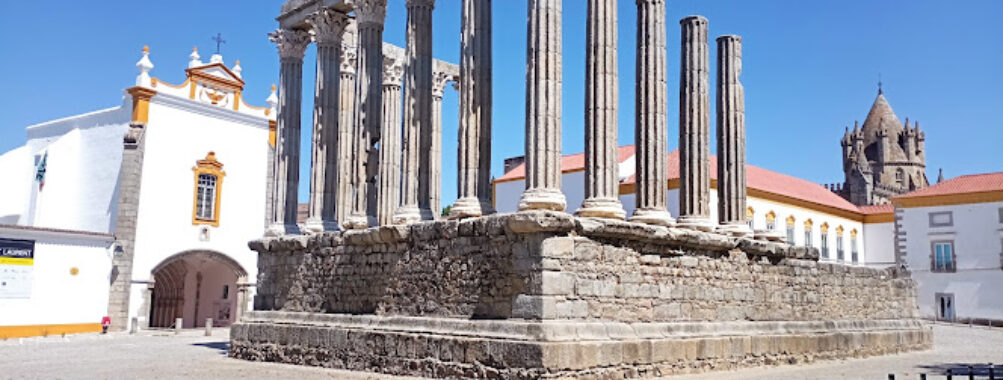
Roman Temple of Évora
Table of Contents
Description
Standing proudly in the heart of Évora’s historic center, the Roman Temple (sometimes called the Temple of Diana) is easily one of Portugal’s most impressive ancient monuments. I’ve gotta say, when I first laid eyes on it, I was absolutely blown away by how well-preserved those Corinthian columns are – and they’ve been standing there since the 1st century AD! It’s pretty mind-blowing to think this temple has survived nearly 2,000 years of history.
The temple was originally built to honor Emperor Augustus, and boy, does it show off that classic Roman architectural swagger. Those fourteen granite columns topped with marble capitals just scream imperial grandeur. And y’know what’s really cool? The temple actually spent centuries hidden inside the walls of a medieval building – talk about a preservation technique! It wasn’t until the 1800s that someone finally decided to tear down those walls and show this beauty to the world again.
Key Features
• Original Corinthian columns standing 7.68 meters (25 feet) high
• Gorgeous marble capitals still intact after all these years
• Massive granite base with original Roman construction
• Six columns across the front facade
• Five columns along each side
• Spectacular nighttime illumination that makes those columns glow
• Located in Évora’s main square, surrounded by other historic buildings
• Part of the UNESCO World Heritage site of Évora’s historic center
• One of the best-preserved Roman temples on the Iberian Peninsula
• Traditional Portuguese limestone pavement surrounding the temple
Best Time to Visit
From my experience, early morning or late afternoon are your best bets for visiting the Roman Temple. The lighting at these times is absolutely perfect for photography – the way the sun hits those columns is just *chef’s kiss*. Summer months can get pretty toasty in Évora (I learned that the hard way!), so if you’re visiting between June and August, definitely aim for those cooler morning hours.
Winter visits have their own charm – fewer tourists and some gorgeously moody cloudy days that make the temple look extra dramatic. But dress warm! Those Alentejo winters can be chillier than you’d expect. And if you can swing it, try to catch the temple at sunset – the way the golden light plays off the ancient stone is something else entirely.
How to Get There
Getting to the Roman Temple is actually pretty straightforward – it’s right in the historic center of Évora. If you’re driving (like I did), you’ll want to park in one of the public lots just outside the old city walls, since the historic center is mostly pedestrian-only. Trust me, trying to navigate those narrow medieval streets by car is not fun!
From Lisbon, you’ve got several options. The train takes about 1.5 hours and drops you at Évora station, then it’s just a 15-minute walk to the temple. Buses are another solid choice – they run regularly from Lisbon’s Sete Rios station. But my personal recommendation? Rent a car. The Alentejo region is gorgeous, and having your own wheels lets you explore some of the less touristy spots around Évora.
Tips for Visiting
Alright, here’s the inside scoop from someone who’s been there multiple times – the temple is always open since it’s outdoors, but the best views are definitely from the square’s cafe terraces. Grab yourself an espresso and a pastel de nata, and just soak in those ancient vibes.
Bring your camera, obviously, but don’t forget to pack sunscreen and water, especially in summer. The square can be like a solar oven on hot days! And while you’re there, make sure to check out the nearby Cathedral and the Chapel of Bones – they’re literally just a few minutes’ walk away.
Oh, and here’s a pro tip: the temple is beautiful during the day, but it’s absolutely magical at night when it’s lit up. If you can, stick around after sunset – the atmosphere is totally different, and there are way fewer tourists. Plus, some of the nearby restaurants serve amazing traditional Alentejo cuisine – perfect for a post-sightseeing dinner.
For the history buffs out there (I’m looking at you!), consider hiring a local guide. They can tell you some fascinating stories about the temple’s history that you won’t find in guidebooks. And don’t rush your visit – this isn’t just another old building to tick off your list. Take your time, walk around the entire structure, and really appreciate the incredible engineering that’s kept it standing for two millennia.
Lastly, if you’re into photography, morning light tends to be best for capturing the temple’s details, but sunset gives you those warm, golden tones that look incredible in photos. Just watch out for the midday sun – it can wash out your shots something terrible!
Location
Places to Stay Near Roman Temple of Évora
Find and Book a Tour
Explore More Travel Guides
No reviews found! Be the first to review!